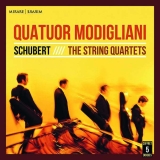Zum kleinen Jubiläum, dem 225. Geburtsjahr von Schubert, legt das Quatuor Modigliani die Gesamteinspielung der Streichquartette vor. Auf fünf CDs haben sie jeweils Werke nebeneinandergestellt, die sie jeweils unter einer Überschrift verklammern, als da sind Harmonie, Die Kunst des Gesangs, Der Geist der Klassik, Gemütszustände und Licht und Schatten. Um den verschiedenen Charakteren Rechnung zu tragen, dem eher klassischen der frühen Werke der Schaffensphase 1811-16 und den romantisch geprägten der späten Phase 1820-1824, haben sie drei verschiedene Aufnahmeorte und für die beiden Zeiträume unterschiedliche Spielstile gewählt. Ansonsten aber haben sie einheitlich auf neuen Instrumenten gespielt. Mit dieser Aufnahme haben sie sich daneben zur Volljährigkeit ihres Ensembles auch selber ein Geschenk gemacht.
Gleich beim ersten Quartett, mit dem die erste CD Harmonie eröffnet, stellen sie einige Weichen. So zeigen sie Schubert als tief in der klassischen Ausdrucksweise, aber souverän arbeitenden Komponisten. Da ist nichts wehleidig oder lieblich oder gar biedermeierlich. Das klingt selbstbewusst sicher und strukturiert. Dazu trägt ihr erlesenes Zusammenspiel bei, dass man auch bei anderen guten Quartetten nicht immer so deckungsgleich und fein abgestimmt hört. Hier haben sich vier Musiker gefunden, die ohne jede Schwäche miteinander kommunizieren. So erzeugen sie, hier zumindest, ein leichtes und durchhörbares Klangbild, das jede Stimme durchlässt und trotzdem als Einheit aufscheint. Das ist beeindruckend glatt, ohne fallen gelassene Maschen oder Knoten gewoben.
Ihr Aufbau der CDs schließt auf der letztnummerierten Scheibe, benannt Licht und Schatten, mit dem letzten Quartett, das vorhergehende Werk mit dem Titel ‘Der Tod und das Mädchen‘ hat seinen Platz als Abschlusswerk auf der vierten CD, Gemütszustände, gefunden.Soweit vermittelt die Gesamteinspielung im Konzept ein geschlossenes wunderschönes Bild.
Und trotzdem frage ich mich nach mehr als sechs Stunden Musik, was mir bleibt. Und dann kommt der Punkt, dass es sehr, sehr schön, eben edel ist, aber die tiefere Schicht in der Musik nicht so zum Tragen kommt. Das mag man auf das d-Moll fokussieren, aber nicht nur. Hier höre ich im Andante con moto eher ein Mädchen auf der blumenbestandenen Wiese, das von Schmetterlingen umflattert wird als eine bedrückende Szenerie. Und das geht mir schon im ersten Satz so, dass es wunderbar gespielt ist. Also, man genießt, ohne überwältigt zu sein.
For the small anniversary, the 225th birth year of Schubert, the Quatuor Modigliani presents the complete recording of the string quartets. On five CDs, they have juxtaposed works that they bracket under one heading, such as Harmony, The Art of Song, The Classical Spirit, Sentiments of the Soul, and Light and Shadow. To take care of the different characters, the more classical of the early works of the 1811-16 creative period and the more romantic of the late 1820-1824 phase, they chose three different recording locations and different playing styles for the two periods. Otherwise, however, they have played uniformly on new instruments. With this recording, they have also given themselves a gift to celebrate their ensemble’s coming of age.
Right from the first quartet, with which the first CD Harmony opens, they set some course. For example, they show Schubert as a composer deep in classical expression, but working with aplomb. There is nothing snivelling or mellifluous or even Biedermeier. It sounds confidently assured and structured. Their exquisite interplay contributes to this, which one does not always hear so congruent and finely tuned even in other good quartets. Here four musicians have found each other, who communicate with each other without any weakness. So they create, here at least, a light and audible sound that lets each voice through and still appears as a unity. This is impressively smoothly woven without dropped meshes or knots.
Their structure of CDs concludes on the last numbered disc, named Light and Shadow, with the final quartet, the previous work entitled ‘Death and the Girl’ having found its place as the closing work on the fourth CD, Sentiments of the Soul. So far, the overall recording conveys a cohesive beautiful picture in concept.
And yet, after more than six hours of music, I wonder what I am left with. And then comes the point that it is very, very beautiful, noble, but the deeper layer in the music does not come through as much. You might focus that in the D minor, but not only. Here, in the Andante con moto, I hear more of a girl in a flower-strewn meadow with butterflies fluttering around her than a depressing scene. And I feel that way in the first movement, that it is beautifully played. But one enjoys without being overwhelmed.






















